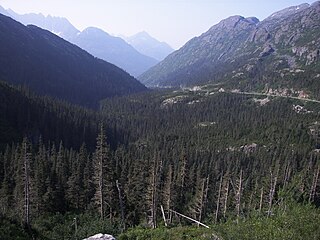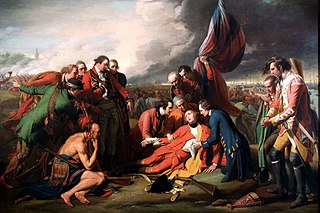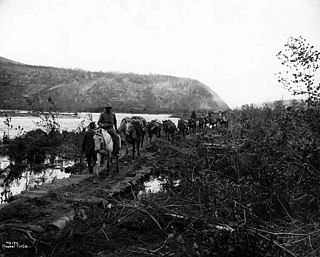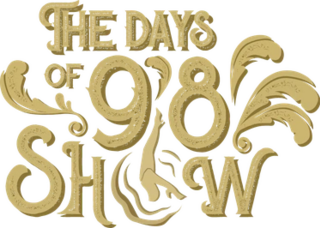
Pierre Francis de Marigny Berton, CC, O.Ont. was a Canadian historian, writer, journalist and broadcaster. Berton wrote 50 best-selling books, mainly about Canadiana, Canadian history and popular culture. He also wrote critiques of mainstream religion, anthologies, children's books and historical works for youth. He was a reporter and war correspondent, an editor at Maclean's Magazine and The Toronto Star and, for 39 years, a guest on Front Page Challenge. He was a founder of the Writers' Trust of Canada, and won many honours and awards.

The Municipality and Borough of Skagway is a first-class borough in Alaska on the Alaska Panhandle. As of the 2020 census, the population was 1,240, up from 968 in 2010. The population doubles in the summer tourist season in order to deal with the large number of summer tourists each year. Incorporated as a borough on June 25, 2007, it was previously a city in the Skagway-Yakutat-Angoon Census Area. The most populated community is the census-designated place of Skagway.

A gold rush or gold fever is a discovery of gold—sometimes accompanied by other precious metals and rare-earth minerals—that brings an onrush of miners seeking their fortune. Major gold rushes took place in the 19th century in Australia, Greece, New Zealand, Brazil, Chile, South Africa, the United States, and Canada while smaller gold rushes took place elsewhere.

The Klondike Gold Rush was a migration by an estimated 100,000 prospectors to the Klondike region of Yukon in northwestern Canada, between 1896 and 1899. Gold was discovered there by local miners on August 16, 1896; when news reached Seattle and San Francisco the following year, it triggered a stampede of prospectors. Some became wealthy, but the majority went in vain. It has been immortalized in films, literature, and photographs.

Mackenzie River husky describes several overlapping historical populations of Arctic and sub-Arctic sled dog originally bred to support fur traders for Hudson's Bay Company and later prospectors during the Klondike Gold Rush. A mixture of native sled dogs and European freighting dogs, Mackenzie River huskies were prized for their ability to haul heavy loads long distances in the snow with minimal care. Since the advent of modern mechanized travel in the Arctic, moving cargo by dogsled has become nearly obsolete and only small populations of these dogs still exist.

Placer mining is the mining of stream bed deposits for minerals. This may be done by open-pit mining or by various surface excavating equipment or tunneling equipment.

The District of Alaska was the federal government’s designation for Alaska from May 17, 1884, to August 24, 1912, when it became the Territory of Alaska. Previously (1867–1884) it had been known as the Department of Alaska, a military designation.

The Chilkoot Trail is a 33-mile (53 km) trail through the Coast Mountains that leads from Dyea, Alaska, in the United States, to Bennett, British Columbia, in Canada. It was a major access route from the coast to Yukon goldfields in the late 1890s. The trail became obsolete in 1899 when a railway was built from Dyea's neighbor port Skagway along the parallel White Pass trail.

White Pass, also known as the Dead Horse Trail, is a mountain pass through the Boundary Ranges of the Coast Mountains on the border of the U.S. state of Alaska and the province of British Columbia, Canada. It leads from Skagway, Alaska, to the chain of lakes at the headwaters of the Yukon River.

Klondike Gold Rush National Historical Park is a national historical park operated by the National Park Service that seeks to commemorate the Klondike Gold Rush of the late 1890s. Though the gold fields that were the ultimate goal of the stampeders lay in Yukon, the park comprises staging areas for the trek there and the routes leading in its direction. There are four units, including three in Municipality of Skagway Borough, Alaska and a fourth in the Pioneer Square National Historic District in Seattle, Washington.

The history of the Yukon covers the period from the arrival of Paleo-Indians through the Beringia land bridge approximately 20,000 years ago. In the 18th century, Russian explorers began to trade with the First Nations people along the Alaskan coast, and later established trade networks extending into Yukon. By the 19th century, traders from the Hudson's Bay Company were also active in the region. The region was administered as a part of the North-Western Territory until 1870, when the United Kingdom transferred the territory to Canada and it became the North-West Territories.
The Alaska Gold Rush was a gold rush in the Klondike region of the Yukon in Canada from 1896 to 1899.

The Nome Gold Rush was a gold rush in Nome, Alaska, approximately 1899–1909. It is separated from other gold rushes by the ease with which gold could be obtained. Much of the gold was lying in the beach sand of the landing place and could be recovered without any need for a claim. Nome was a sea port without a harbor, and the biggest town in Alaska.

Carrie Mary McLain was an American writer and teacher known for her histories and memorabilia of Alaska.
The Klondike Gold Rush is commemorated through film, literature, historical parks etc.
Gold Trails and Ghost Towns is a Canadian historical documentary show, created and produced by television station CHBC-TV in Kelowna, British Columbia for Canadian syndication and hosted by Mike Roberts with historian/storyteller Bill Barlee. The show was filmed in a studio which resembled an old trapper's cabin. Mike and Bill discussed prospectors and the history of British Columbia around 1900.

Thomas Sergent Lippy, know variously as T. S. Lippy, Thomas Lippy or Tom S. Lippy, was an American millionaire and philanthropist who became wealthy as a prospector in the Klondike Gold Rush.

Fannie Quigley was an American pioneer and prospector and cook who became involved in mining operations during the Klondike Gold Rush. Living in the wilderness of what is now Denali National Park and Preserve in Alaska, she was known for her hunting, trapping, and cooking skills.

Klondike is an American drama series about life in an Alaskan town in the 1890s during the Klondike Gold Rush. It stars Ralph Taeger and James Coburn and aired on NBC during the 1960–61 television season.

The Days of '98 Show is a Klondike Gold Rush–themed musical theater show performed in Eagles Hall in Skagway, Alaska. It is the longest-running Alaskan theatrical show. Created in the 1920s, the show was put on by the Skagway chapter of the Fraternal Order of Eagles and performed infrequently in the 1930s. By the mid-20th century, the show was performed frequently in the summer, particularly on days when cruise ships and passenger ships docked. It was staffed by unpaid locals and used to fundraise for various causes including a local hockey team, an elderly care facility, and Christmas toys for all Skagway children.

















